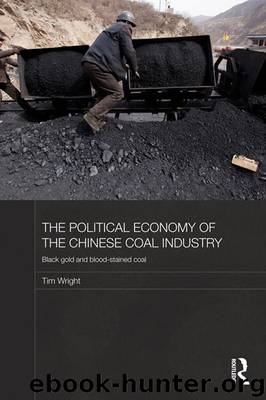The Political Economy of the Chinese Coal Industry: Black Gold and Blood-Stained Coal by Tim Wright

Author:Tim Wright [Wright, Tim]
Language: eng
Format: epub
Tags: General, economics, Social Science, Technology & Engineering, Business & Economics, Industries, Ethnic Studies, Development, Economic Development, Economic Conditions, Technical & Manufacturing Industries & Trades
ISBN: 9780415493284
Publisher: Routledge
Published: 2011-12-02T00:00:00+00:00
Source: Disanci quanguo gongye pucha 1997b: 21, 22, 521, 522.
Notes: Ash and He 1998: 15 define these terms as follows: profits from product sales equal sales revenue minus cost of goods sold, minus selling expenses and minus taxes on sales and other related taxes. Total realized profits equal profits from product sales plus net revenue from investments, plus non-operational income and minus non-operational expenses. ‘Non-operational expenses’, the largest factor in the difference between the two measures, is made up mainly of the costs of management and social welfare provisions.
Several factors explain the greater burdens of coal enterprises. First, mines tended to be in isolated locations, increasing the obligation to provide social services (Zhao Tiechui 2001: 96, 101). In the relatively remote Jalainur coal mine in eastern Inner Mongolia, 80 per cent of the local population depended on the mine, which ran seventeen middle and primary schools, six hospitals and the local water, electricity, public security, fire prevention, flood prevention, and environmental protection services. The total cost of these services was 60 million yuan, which seriously constrained the company’s development (Wang Zhimei and He Ming 2004: 8).
Second, the nature of the job meant that miners could work underground for only a limited period, after which they had to be transferred to surface duties and replaced. So, the proportion of workers retired or not directly involved in production was higher than average. Coal had a ratio of 3.3 active workers per retired worker, as against 4.9 in ten other industries, including electric power. Finally, the health problems caused by working in coal mines also increased ‘non-productive’ expenditures on medical care (Xu Zhaotang et al. 2003: 45; Li Zhenwen et al. 1999: 99; Pan 1996: 112).
Particularly since 1997, the state has promoted SOE reforms in order to divest them of these social functions, and Holz (2002: 519–20) credits this with some of the general improvement in SOE performance from 1998. But even then the factors outlined above meant that the coal industry was among the last to adjust (Wu Daorong and Hao Huguan 2003: 10). Coal SOEs reduced their workforce – numbers fell by 20 per cent between 1997 and 2001 (ZMGX 2006: 517) – but financial performance really began to improve only from 2000. Scholars question whether the companies have been able to shed financial responsibility for laid-off workers (Interview 2004a). In addition, much of the benefit of improved productivity was used to increase wages (which had previously been irrationally low) and investment, particularly in safety (Interview 2004b). Thus, the reforms had less effect on costs than on labour productivity: official sources claim that costs in the major Shanxi mines fell in 1999, but then rose by 4.7 per cent in 2001 and by over 13 per cent in 2002 (SJN 2000: 97, 2002: 106, and 2003: 115). Coal industry experts in China believe that the high profits of the early 2000s were due mainly to rising prices and the improved national economy rather than to the acceleration of SOE reform, and
Download
This site does not store any files on its server. We only index and link to content provided by other sites. Please contact the content providers to delete copyright contents if any and email us, we'll remove relevant links or contents immediately.
The Brazilian Economy since the Great Financial Crisis of 20072008 by Philip Arestis Carolina Troncoso Baltar & Daniela Magalhães Prates(105948)
International Integration of the Brazilian Economy by Elias C. Grivoyannis(75744)
The Art of Coaching by Elena Aguilar(52214)
Flexible Working by Dale Gemma;(23213)
How to Stop Living Paycheck to Paycheck by Avery Breyer(19572)
The Acquirer's Multiple: How the Billionaire Contrarians of Deep Value Beat the Market by Tobias Carlisle(12115)
Thinking, Fast and Slow by Kahneman Daniel(11808)
The Radium Girls by Kate Moore(11639)
The Art of Thinking Clearly by Rolf Dobelli(9930)
Hit Refresh by Satya Nadella(8870)
The Compound Effect by Darren Hardy(8527)
Atomic Habits: Tiny Changes, Remarkable Results by James Clear(8055)
Tools of Titans by Timothy Ferriss(7828)
Turbulence by E. J. Noyes(7717)
Change Your Questions, Change Your Life by Marilee Adams(7388)
A Court of Wings and Ruin by Sarah J. Maas(7286)
Nudge - Improving Decisions about Health, Wealth, and Happiness by Thaler Sunstein(7261)
How to Be a Bawse: A Guide to Conquering Life by Lilly Singh(7167)
Win Bigly by Scott Adams(6836)
